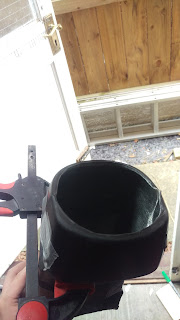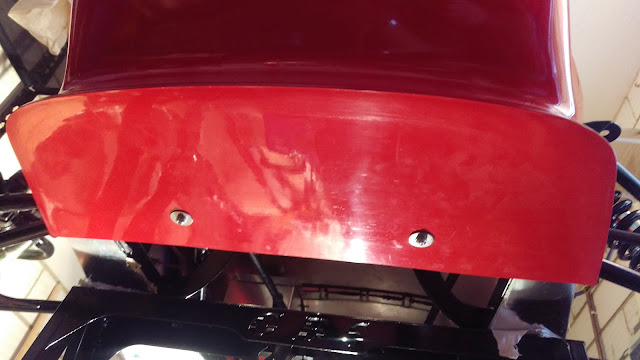I really enjoyed this part, it took me around 12 hours to do (!!) but I found it really rewarding. I was unable to source a second hand cowling set and after posting on the forum a member there was making replicas from GRP - great. It required a lot of finishing off, that was expected and although the copy I got was very good quality I wasn't 100% happy with the final finish so decided I was going the whole hog and really pleased with end result.
Here is what I started with:
It looks rough round the edges, but actually that makes sense - the bits that count are fine, its only the parts which need cutting out that look "rough", after purchasing some propper plastic bits for my dremmel it was like a knife through butter:
All clamped up ready for some serious sanding, measurng and checking:
And this is the point I decided I was going to sand and paint:
You can see the fit is fine but I wasn't happy with either the rubber strip between each section and the final colour, even though it's not really seen I couldnt help spending the time to get it right. So, after lots (and lots) of sanding, filling and cleaning:
I managed to get a couple of coats on before finishing up:
I think you will agree the finished result in the morning was well worth the extra effort:
Very happy. This next week will be tidying up, I have started but it will take a few days (!!). I've torqued the hub nuts up, need to setup the suspension was the wheels are on order.....
Sunday, 29 May 2016
Dash Finishing (pre clocks)
First update in a while and I have been busy, that's with the car, work and other stuff going on at the moment! Sticking with the car then, lots to write up about.
Ill start with the dash board - something that was far easier to tackle with a removable scuttle, but I have to say I found the dash a real pain after the 5 hour point - you will see why later. OK so scuttle off and we are ready to go:
I wanted to cover up the (what would be) horrendous gap between the top edge of the GRP and the top of scuttle. As the GRP is made in the factory yet the scuttle is formed by hand, its no wonder there is a small gap visible between the two. As this is something I will be in the line of sight whilst driving I wanted to take my time and get it right. Speaking to a friend they suggested some leatherette, which is exactly what I went with. After purchasing a meter and buying a glue gun I set about fixing it, first some padding attached to stop any rattles:
After lots of messing about here was the intermediate stage:
The mistake I made here was rivnutting before I attached the material. I thought that I could simply open up the leatherette, poke the bolts through and away we go. That's fine in theory but in practise nearly every single one threaded. I think a mix of my obsessive measuring and parts of the material getting into the thread caused the problem. I don't think I could get the correct angle on the thread, because of very little wiggle room. I ended up having to drill each rivet out and went with lock nuts on the rear - it seems good enough to me and I can remove the dash still. I used some dome washers and countersunk bolts, looks good:
Next was onto the cut out for the Cowling, the steering column is on but only hand tight - I will torque it up properly later when I am 100% sure on how everything works. A little piece of my OCD set in here, but it paid off. First I made a template with clear instructions for if\when the frustration sets in:
The edge of the template lines up with the dashboard meaning I can remove it and line it up perfectly once the final template is made:
I made a master and WIP copy, the master stays as is should I make any mistakes on the WIP copy I can create another one:
All that was left now was to get the Cowling sorted...
Ill start with the dash board - something that was far easier to tackle with a removable scuttle, but I have to say I found the dash a real pain after the 5 hour point - you will see why later. OK so scuttle off and we are ready to go:
I wanted to cover up the (what would be) horrendous gap between the top edge of the GRP and the top of scuttle. As the GRP is made in the factory yet the scuttle is formed by hand, its no wonder there is a small gap visible between the two. As this is something I will be in the line of sight whilst driving I wanted to take my time and get it right. Speaking to a friend they suggested some leatherette, which is exactly what I went with. After purchasing a meter and buying a glue gun I set about fixing it, first some padding attached to stop any rattles:
After lots of messing about here was the intermediate stage:
The mistake I made here was rivnutting before I attached the material. I thought that I could simply open up the leatherette, poke the bolts through and away we go. That's fine in theory but in practise nearly every single one threaded. I think a mix of my obsessive measuring and parts of the material getting into the thread caused the problem. I don't think I could get the correct angle on the thread, because of very little wiggle room. I ended up having to drill each rivet out and went with lock nuts on the rear - it seems good enough to me and I can remove the dash still. I used some dome washers and countersunk bolts, looks good:
Next was onto the cut out for the Cowling, the steering column is on but only hand tight - I will torque it up properly later when I am 100% sure on how everything works. A little piece of my OCD set in here, but it paid off. First I made a template with clear instructions for if\when the frustration sets in:
The edge of the template lines up with the dashboard meaning I can remove it and line it up perfectly once the final template is made:
I made a master and WIP copy, the master stays as is should I make any mistakes on the WIP copy I can create another one:
All that was left now was to get the Cowling sorted...
Sunday, 15 May 2016
Nose Cone and Bonnet Day Two
I say day two...this has taken me around a week to do, well worth it. For the bonnet I definitely took my time, my focus was on achieving a factory finish (as much as possible) and I am really pleased with the results. The only thing I need to do is get some thinner foam strip to run along the edge of the bonnet where it sits on the scuttle and nose cone. The stuff I have is 6mm thick and it needs to be at least half that, otherwise the bonnet doesn't sit right.
You can see from the pics that its 99% there but there are a couple of areas around the nose that I want to pull a little tighter and hopefully a thin strip of foam will do just that.
Ratchet straps used to get the bonnet into position, a god send:
Used my rule to make sure I didn't have a lip anywhere, looking good:
Next was working out where to put the bonnet locator pins. I know on the left hand side the manifold comes out, once the engine is in I can put another locator pin in but for now I have gone with four. Easiest way to do this was to mark up where I want the pin on the bonnet and chassis when bonnet is in place, then drill a small pilot hole central. Then, fit the bonnet again and mark through the pilot hole and open each side up - finally finishing with a file and testing with spare locator pin for flush fit.
I decided to screw on the headlights so I could put the spade ends and terminals on ready to run the wring loom, but after looking in detail I really need to do the front wiring loom after I have a few more bits in e.g E-N-G-I-N-E (I am looking forward to that part!).
Here she is:
You can see from the pics that its 99% there but there are a couple of areas around the nose that I want to pull a little tighter and hopefully a thin strip of foam will do just that.
Ratchet straps used to get the bonnet into position, a god send:
Used my rule to make sure I didn't have a lip anywhere, looking good:
Next was working out where to put the bonnet locator pins. I know on the left hand side the manifold comes out, once the engine is in I can put another locator pin in but for now I have gone with four. Easiest way to do this was to mark up where I want the pin on the bonnet and chassis when bonnet is in place, then drill a small pilot hole central. Then, fit the bonnet again and mark through the pilot hole and open each side up - finally finishing with a file and testing with spare locator pin for flush fit.
The nose cone was only held in place with clips whilst I made sure the bonnet fit was correct with the scuttle, then tapped the nose into place at the other end and securely fixed nose after applying IVA trim:
I decided to screw on the headlights so I could put the spade ends and terminals on ready to run the wring loom, but after looking in detail I really need to do the front wiring loom after I have a few more bits in e.g E-N-G-I-N-E (I am looking forward to that part!).
Here she is:
Subscribe to:
Comments (Atom)

































